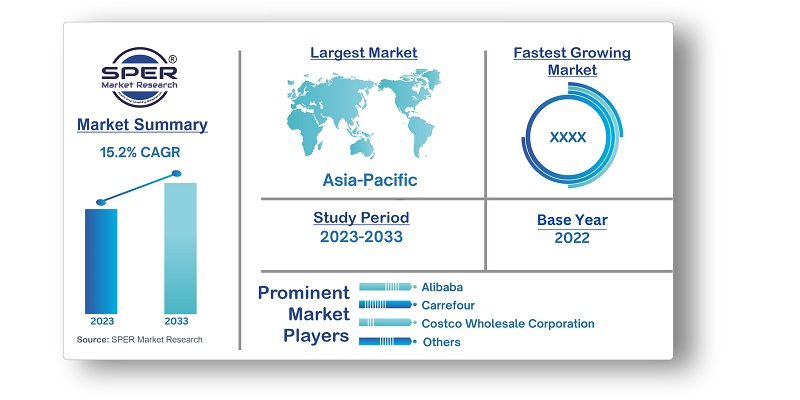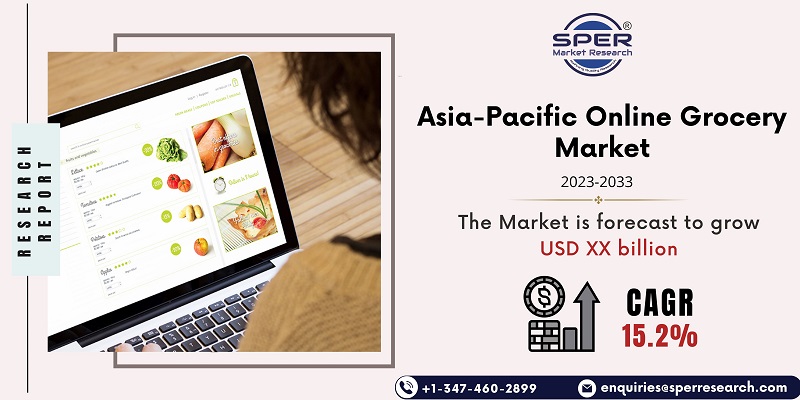
Asia Pacific Online Grocery Market Growth, Size, Trends, Share, Revenue and Future Competition
Asia Pacific Online Grocery Market Size- By Product Type, By Delivery Type- Regional Outlook, Competitive Strategies and Segment Forecast to 2033
| Published: Jan-2024 | Report ID: FMCG2408 | Pages: 1 - 153 | Formats*: |
| Category : Consumer & Retail | |||
- February 2022: Swiggy's Instamart in India has announced a partnership with Zepto, a rapid commerce firm based in Mumbai. It is hoped that the collaboration will assist both businesses in introducing private-label goods. Products sold by shops under their own brand names are known as private-label products. Private-label goods give the store a larger profit margin, hence many e-commerce businesses sell them.
- February 2022: Rakuten Group, Inc. declared the opening of "Rakuten Zenkoku Super," their online grocery delivery service in Japan. The next phase of Japanese grocery buying development is represented by Rakuten Zenkoku Super. With the help of this newly built service, supermarkets around the country will be able to reach new demographics and geographic areas by providing them with a comprehensive online grocery buying platform. The platform is made to quickly deliver products to customers.


| Report Metric | Details |
| Market size available for years | 2019-2033 |
| Base year considered | 2022 |
| Forecast period | 2023-2033 |
| Segments covered | By Product Type, By Delivery Type |
| Regions covered | Australia, China, India, Indonesia, Japan, South Korea, Thailand and rest of Asia-Pacific |
| Companies Covered | Alibaba, Amazon.com, Inc., Carrefour, Costco Wholesale Corporation, Koninklijke Ahold Delhaize N.V., LuLu Hypermarket, Rakuten Group, Inc., Reliance Retail Ltd., Supermarket Grocery Supplies Private Limited. Target Brands, Inc., Tesco, Walmart Inc., Zomato, Others |
- Busy Professionals
- Elderly or Disabled Individuals
- Price-Conscious Shoppers
- Subscription-Based Customers
- Urban Dwellers
- Others
| By Product Type: |
|
| By Delivery Type: |
|
| By Region: |
|
- Asia-Pacific Online Grocery Market Size (FY’2023-FY’2033)
- Overview of Asia-Pacific Online Grocery Market
- Segmentation of Asia-Pacific Online Grocery Market By Product Type (Breakfast and Dairy, Fresh Produce, Meat and Seafood, Snacks and Beverages, Staples and Cooking Essentials, Others)
- Segmentation of Asia-Pacific Online Grocery Market By Delivery Type (Click and Collect, Home Delivery)
- Statistical Snap of Asia-Pacific Online Grocery Market
- Expansion Analysis of Asia-Pacific Online Grocery Market
- Problems and Obstacles in Asia-Pacific Online Grocery Market
- Competitive Landscape in the Asia-Pacific Online Grocery Market
- Impact of COVID-19 and Demonetization on Asia-Pacific Online Grocery Market
- Details on Current Investment in Asia-Pacific Online Grocery Market
- Competitive Analysis of Asia-Pacific Online Grocery Market
- Prominent Players in the Asia-Pacific Online Grocery Market
- SWOT Analysis of Asia-Pacific Online Grocery Market
- Asia-Pacific Online Grocery Market Future Outlook and Projections (FY’2023-FY’2033)
- Recommendations from Analyst
1.1. Scope of the report1.2. Market segment analysis
2.1. Research data source2.1.1. Secondary Data2.1.2. Primary Data2.1.3. SPER’s internal database2.1.4. Premium insight from KOL’s2.2. Market size estimation2.2.1. Top-down and Bottom-up approach2.3. Data triangulation
4.1. Driver, Restraint, Opportunity and Challenges analysis4.1.1. Drivers4.1.2. Restraints4.1.3. Opportunities4.1.4. Challenges4.2. COVID-19 Impacts of the Asia-Pacific Online Grocery Market
5.1. SWOT Analysis5.1.1. Strengths5.1.2. Weaknesses5.1.3. Opportunities5.1.4. Threats5.2. PESTEL Analysis5.2.1. Political Landscape5.2.2. Economic Landscape5.2.3. Social Landscape5.2.4. Technological Landscape5.2.5. Environmental Landscape5.2.6. Legal Landscape5.3. PORTER’s Five Forces5.3.1. Bargaining power of suppliers5.3.2. Bargaining power of buyers5.3.3. Threat of Substitute5.3.4. Threat of new entrant5.3.5. Competitive rivalry5.4. Heat Map Analysis
6.1. Asia-Pacific Online Grocery Market Manufacturing Base Distribution, Sales Area, Product Type6.2. Mergers & Acquisitions, Partnerships, Product Launch, and Collaboration in Asia-Pacific Online Grocery Market
7.1. Asia-Pacific Online Grocery Market Value Share and Forecast, By Product Type, 2023-20337.2. Breakfast and Dairy7.3. Fresh Produce7.4. Meat and Seafood7.5. Snacks and Beverages7.6. Staples and Cooking Essentials7.7. Others
8.1. Asia-Pacific Online Grocery Market Value Share and Forecast, By Delivery Type, 2023-20338.2. Click and Collect8.3. Home Delivery
9.1. Asia-Pacific Online Grocery Market Size and Market Share
10.1. Asia-Pacific Online Grocery Market Size and Market Share By Product Type (2019-2026)10.2. Asia-Pacific Online Grocery Market Size and Market Share By Product Type (2027-2033)
11.1. Asia-Pacific Online Grocery Market Size and Market Share By Delivery Type (2019-2026)11.2. Asia-Pacific Online Grocery Market Size and Market Share By Delivery Type (2027-2033)
12.1. Asia-Pacific Online Grocery Market Size and Market Share By Region (2019-2026)12.2. Asia-Pacific Online Grocery Market Size and Market Share By Region (2027-2033)12.3. Australia12.4. China12.5. India12.6. Indonesia12.7. Japan12.8. South Korea12.9. Thailand12.10. Rest of Asia-Pacific
13.1. Alibaba13.1.1. Company details13.1.2. Financial outlook13.1.3. Product summary13.1.4. Recent developments13.2. Amazon.com, Inc.13.2.1. Company details13.2.2. Financial outlook13.2.3. Product summary13.2.4. Recent developments13.3. Carrefour13.3.1. Company details13.3.2. Financial outlook13.3.3. Product summary13.3.4. Recent developments13.4. Costco Wholesale Corporation13.4.1. Company details13.4.2. Financial outlook13.4.3. Product summary13.4.4. Recent developments13.5. Koninklijke Ahold Delhaize N.V.13.5.1. Company details13.5.2. Financial outlook13.5.3. Product summary13.5.4. Recent developments13.6. LuLu Hypermarket13.6.1. Company details13.6.2. Financial outlook13.6.3. Product summary13.6.4. Recent developments13.7. Rakuten Group, Inc.13.7.1. Company details13.7.2. Financial outlook13.7.3. Product summary13.7.4. Recent developments13.8. Reliance Retail Ltd13.8.1. Company details13.8.2. Financial outlook13.8.3. Product summary13.8.4. Recent developments13.9. Supermarket Grocery Supplies Private Limited13.9.1. Company details13.9.2. Financial outlook13.9.3. Product summary13.9.4. Recent developments13.10. Target Brands, Inc.13.10.1. Company details13.10.2. Financial outlook13.10.3. Product summary13.10.4. Recent developments13.11. Tesco13.11.1. Company details13.11.2. Financial outlook13.11.3. Product summary13.11.4. Recent developments13.12. Walmart Inc.13.12.1. Company details13.12.2. Financial outlook13.12.3. Product summary13.12.4. Recent developments13.13. Zomato13.13.1. Company details13.13.2. Financial outlook13.13.3. Product summary13.13.4. Recent developments13.14. Others
SPER Market Research’s methodology uses great emphasis on primary research to ensure that the market intelligence insights are up to date, reliable and accurate. Primary interviews are done with players involved in each phase of a supply chain to analyze the market forecasting. The secondary research method is used to help you fully understand how the future markets and the spending patterns look likes.
The report is based on in-depth qualitative and quantitative analysis of the Product Market. The quantitative analysis involves the application of various projection and sampling techniques. The qualitative analysis involves primary interviews, surveys, and vendor briefings. The data gathered as a result of these processes are validated through experts opinion. Our research methodology entails an ideal mixture of primary and secondary initiatives.



Frequently Asked Questions About This Report
PLACE AN ORDER
Year End Discount
Sample Report
Pre-Purchase Inquiry
NEED CUSTOMIZATION?
Request CustomizationCALL OR EMAIL US
100% Secure Payment






Related Reports
Our Global Clients
Our data-driven insights have influenced the strategy of 200+ reputed companies across the globe.




















